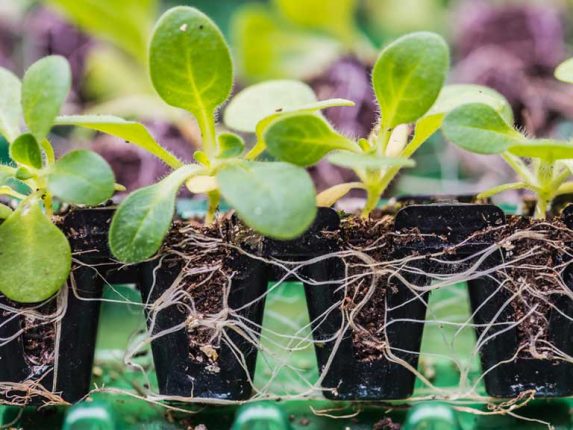While switching to ‘plug plants’ may offer advantages for busy gardeners, watching seeds spring into life never loses its magic for Ursula Buchan
I am slap bang in the middle of the seed-sowing season, that most hectic of times when the ‘windowsill’ propagator is packed with small pots, the staging in the greenhouse is filling up too quickly with seedlings in modules and trays, and I have begun sowing and planting outside in the vegetable beds. What could be more encouraging? What could show more clearly, to myself and to the world, that I am a fully paid-up member of the horticultural fraternity? And what could be better at distracting me from all the other myriad demands of a country garden in spring?
Well, nothing really, except that, this year, I have felt more than a bat squeak of anxiety that I may be wasting my precious time. Has the moment finally arrived when I conclude that it makes more sense to buy ‘plug plants’ of vegetables than sow the seed?

I must coolly consider the evidence. For a start, seed sowing is wasteful. Packets of ordinary vegetables, such as lettuce and carrots, have far too many seeds in them for my needs. Every year I fail to use them all, yet those seeds must be carefully looked after – preferably in an airtight box kept in a cool, dry, dark place – if they are to retain full viability for another year. And some seed, such as parsnip, resolutely refuses to germinate in the second year, whatever you do.
From bitter experience, I know that hardy vegetable seeds sown outside in soil are prone to rot off in wet conditions, if they aren’t eaten by mice (beans and peas), slugs (lettuce) or flea beetle (the brassica family). Which means that I feel compelled to give them a good start by sowing seed in trays or modules kept in the greenhouse or cold frame, which carries with it a cost in pots and compost.
That brings me to the problem of seed composts, for the quality of readily available peat-free media suitable for seeds is way too variable for my liking. I am not alone in thinking so, if my gardening friends are anything like representative. In this garden at least, the hunt is on to find reliable, sustainable, peat-free media before the composts containing peat are banned for sale to home gardeners in or before 2024. (I hope to report on my findings in the autumn.)
The recent doubling of the price of electricity means that, for the first time in many years, I have not heated my greenhouse during the past winter, not even to keep it just frost free. Frost-tender plants (scented pelargoniums and dahlia tubers, for example) have had to find their way into spare bedrooms and on to landing windowsills, or been mummified in insulating fleece. But the seed of tender vegetables, such as tomatoes and peppers, really does need to be sown in late winter or early spring if the fruits are to ripen reliably before the autumn frosts, and that means giving the seedlings some greenhouse heat when the weather is cold or dank in spring.
So what is preventing me from switching to plants? Mail-order seed companies, such as Suttons, Marshalls, Thompson & Morgan and Dobies, have been selling small, so-called plug plants for years. These plants are grown by highly automated processes, so there are substantial economies of scale. And, crucially, I need only buy as many plants as I truly require. That said, mail-order companies – from no fault of their own – are at the mercy of courier services. That can work out fine, but sometimes vulnerable small plants arrive looking as if they have been in the packaging too long, with pale, older leaves and driedup root balls. If I decide to buy plug plants, I am better off browsing in a good garden centre, where I can see exactly what I am buying.
My brain tells me all that, but my heart speaks otherwise, for there is something rather magical about watching deadlooking seeds sprout into green life. A magic, I might add, that never loses its power to charm and invigorate. The 19th-century American essayist Charles Dudley Warner, a friend of Mark Twain’s, put it well: ‘To own a bit of ground, to scratch it with a hoe, to plant seeds and watch the renewal of life – this is the commonest delight of the race, the most satisfactory thing a man can do.’ And a woman, for that matter. That is why I do it and I probably always will.




